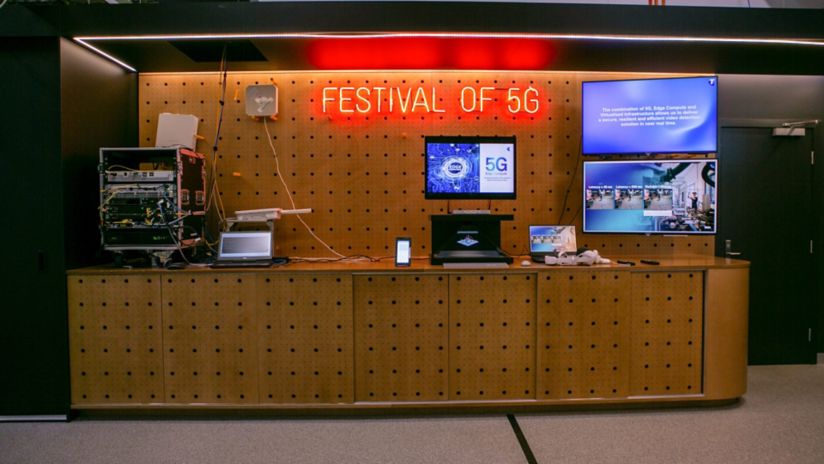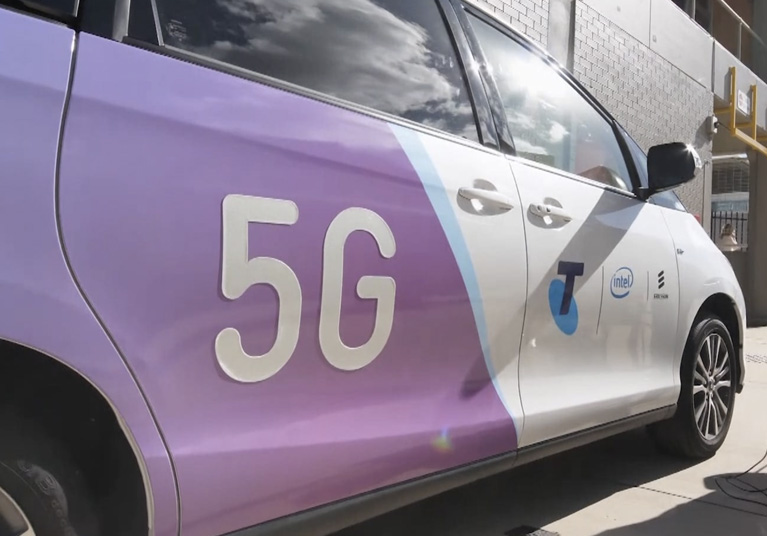Five years of 5G: How we built our world-leading network
It feels like just yesterday we were making the world’s first ever call over a 5G network in 2018. Fast forward to Feb 2023 and we’re now celebrating five years since we launched the 5G Innovation Centre (5GIC) on the Gold Coast.

We’ve come a long way since then, working with industry, communicating and demonstrating 5G and now utilising the latest technology advances are giving our customers the best experience possible on our Network. In the five years from 2017-2022, mobile network traffic has increased by x5.
When we commercially launched our 5G Network in May 2019, we had four 5G devices to buy. Three were mobile handsets and the other was the HTC 5G Hub mobile broadband device – a game-changing form factor device with the blazing fast modem for 5G on the go.
Today, almost every device we sell supports our 5G network, and some even have the addition of mmWave 5G. Our 5G network also now covers over 81% of Australians and counting, can reach peak speeds more than 7x faster than it did at launch, and works more intelligently to be more reliable and support more types of connected devices than any mobile network before it.
These aren’t just words on a page either, with independent industry tests regularly showing the strength of our mobile network. Most recently, industry leader umlaut awarded our network “Best in Test” in Australia after an extensive 55 days of testing.
When it comes to 5G networks, Telstra isn’t just Australia’s leader. We’re also a driving force behind innovation of the technology globally, with nineteen world first advancements and records under our belt. We also have fifteen Australian firsts in 5G.
Leading 5G from the get-go
While we started to build our 5G network in 2018, we actually first started testing 5G technology two years earlier, demonstrating Australia’s first live 5G trial in September 2016. A year later, we made the first 5G data call over a production network as we geared up for the rollout and eventual launch to our customers.
In March 2018, we gave the public the first taste of 5G with our 5G hotspot precinct on the Gold Coast in Queensland, where anyone could connect to our 5G-powered public Wi-Fi network in the area to experience the speed and latency of 5G for the first time.
It was an exciting time for all of us involved, and we even built the first 5G connected-car to celebrate and show an example of how 5G will power not just our mobile phones, but connected devices of all different kinds.
Five months later, our 5G network – the first in Australia – was live across the Gold Coast, Brisbane and Toowoomba. By December that same year, we’d activated over 200 sites across all major cities and started trialing 5G with our first 5G customer, using Australia’s first 5G consumer device – the HTC 5G Hub.
We haven’t stopped innovating and advancing since.
Building Australia’s best 5G network
At first, our priority was and to an extent still is, to make 5G available to as many Australians as possible with the capacity and reliability to serve our growing digital needs. By 2025 we’ll be looking to densify the network even further, with our metro mobile sites set to double, and the 5G network expected to cover 95% of Australians and 80% of all wireless traffic.
We’ve also just finished testing our next step in ensuring that coverage growth. In a world first, the activation of new software that can extend some 5G cells broadcast range from 15KM to 100KM, could potentially be improving the coverage area in remote locations, in certain cases.
But a coverage map is only part of the picture. The technology behind 5G is more advanced and can enable more connectivity use cases than any other mobile technology before it – and we’ve spent a lot of time developing these capabilities.
Something you might have already come across and felt the benefits of though is millimeter-wave 5G, or mmWave 5G – a shorter range, but extremely high-capacity variant of 5G.
If you think of a network like a pipe, you can only force so much down that pipe before things become congested, especially at large scale events such as concerts or sporting matches. We’re always looking to create newer, wider pipes so more data can be carried across our network for more people at once. That’s where mmWave comes in – with a lot more bandwidth to offer.
In September 2019 we enabled Australia’s first stadium (MCG) with 5G, (5G at the ‘G), to start providing the benefits of 5G to our customers at the MCG before the AFL Grand Final. Two years later, we added mmWave 5G to the MCG to provide even more capacity at the ground.
With more bandwidth, it means we can better manage peak congestion periods so you can still post a selfie with 100,000 others at the MCG, for example. But even without a mmWave device, 5G’s greater capacity and latency improvements mean that it can handle many more people on their phones at once than 4G ever could.
We launched the first mmWave capable device in Australia in 2020, the Telstra 5G Wi-Fi Pro – which when we tested on our live network hit speeds over 2Gbps, a giant leap for the time. Just a few months later, we doubled that – hitting 4.2Gbps in September 2020.
At the time, mmWave was also only available in select high traffic areas across the country, but if you have a device that supports it, such as Google’s latest Pixel 7 Pro, you can now find it in more than 300 sites across Australia.
Another of these areas is 5G powered edge computing, which we first trialed at the start of 2019 with a major Australian bank. Edge computing processes and transfers data much closer to where the user is connecting from, rather than coming from across the network – considerably cutting down on data transfer times as well as improving security of the data.
It might not seem important on the surface to everyone, but the lower latency and increased reliability of 5G edge computing lays the groundwork needed for the likes of self-driving cars, more sophisticated remote healthcare, advances in manufacturing as well as providing more resilient and secure services for our customers.
The future of 5G and mobile networks
Our network keeps getting faster, with our most recent commercial 5G world speed record – a mammoth 7.3Gbps set in December last year. Our focus is moving more towards innovating and making it the smartest network with a greater emphasis on automation and consistency, which we see as even more important than raw speed.
We showed off a powerful use case to what that actually enables for everyone last year when alongside our partners, we used 5G to map out Melbourne’s Marvel Stadium to create an internal way finder to help people navigate around the stadium with augmented reality – even indoors.
Once it’s live, you’ll be able to hold up your phone and see superimposed information about where you’re headed around the stadium. Scan your ticket, and the app will guide you right to your seat. You can even use it to find the closest restroom at half-time or the bar with the shortest queue.
As we are seeing at Marvel Stadium, a smarter network improves the network experience for our customers in ways that raw speed can’t. While there are many parts of the network that make it “smart” – we launched several new technologies over the past couple of years that really lay the groundwork for what this means.
The first being Standalone 5G – which enables new network capabilities such as “network slicing”. 5G Standalone technology will allow us to use the latest computing architecture to deliver the network functions in a more intelligent, distributed, resilient, and secure way. We can carve up our world-leading mobile network into separate, secure slices that can be finely tuned to suit the needs of many customers.
These can be used for everything from a business that needs ultra-low latency connections with Edge and 5G, to consumers with dedicated slices for, a popular gaming service which provides a more consistent experience even during periods of high network traffic.
At first, this was a technology that we could manually assign to different customers, but this is now evolving to eventually be automated using artificial intelligence and machine learning to assign “slices” based on the live needs of the network – almost personalising the experience for a user.
This means that as we move forward, no matter the use case a customer has for 5G, the experience should be more reliable, consistent and secure.
Another innovation we began trialing at the end of last year is a new technology called Cloud RAN. It essentially virtualises the baseband which are the brains behind our mobile towers at another centralised cloud location in our Network. This allows us to share resources between many sites to better serve customers as traffic changes across the network. Cloud RAN has the ability to enable more economical, faster and automated deployment of new smart 5G technologies in targeted areas.
Deploying a 5G location needs about 150x the computing power of a 4G site, which means to achieve what 5G is capable of – including slicing and other services – we’d need to upgrade the Radio Access Network (RAN) across thousands of sites. This gradual deployment will start in areas of high density of sites, like cities or enterprises with private networks and then expand to other areas.
These foundations also make way for the likes of 5G Advanced, an upcoming 5G standard that makes better use of artificial intelligence to connect devices more reliably and efficiently to the network. Improvements with uplink speeds and reliability will enable more truly immersive experiences, such as AR and VR on the go, while improved coverage reach and power consumption will allow even more IoT possibilities.
And to top it off – even as we have a lot more left in 5G, these advancing deployments also double as the stepping stones for 6G, which is it’s expected to start to arrive towards the end of this decade. This will open up a world of possibilities we haven’t even thought of yet.
It’s been an exciting five years and the next five years are looking even better.
